The conventional method of defining “economically active population” and “wage earner” preclude women's work within the household or family responsibilities. Consequently, contributions of women are not counted in the GNP, and women's work is usually not recognized as being economically productive. This is aggravated by the fact that rural women are primarily engaged in subsistence rather than commercially-oriented activities, and female labour is customarily classified as “unpaid family workers”. Yet, general observations show that Malaysian women in the rural sector work an average of 15 to 16 hours a day, with half the time spent in self-employed agricultural activities. There is no denying that such activities would indeed supplement the average rural household's income-earning capacity. Unfortunately, there is hardly a census or survey that has adequately documented the full extent of women's economic participation in the rural sector. Hence, women's economic contribution to the rural economy has been not only sadly neglected but also grossly underestimated.
By the same token, the contention that women in the fishing communities are not economically active is highly arguable. Even though tradition and superstitions which linked women with poor catches inhibit their involvement in direct fishing, they are known to perform essential but generally underestimated role in fisheries-related activities such as unloading, sorting, gutting, net mending, processing and distribution and marketing. Such supplementary and supportive roles of the women folks were succintly described by Rosemary Firth (1943) who noted that “........ when the fisherman comes in wet and tired after a day's fishing he expects his wife to be down on the beach, to throw skids for the boats, help in the sale of fish, distribute the free catch allowance to crew members and carry back the husband's fishing gear to the house”. Hence, as far as the men are concern, their share of work is completed once the boats return with their catch, and the women are expected to take over from then onwards. Such tasks although not all of which are necessarily paid and often taken for granted are critical in creating form, place and time utilities which in turn will have tremendous impact on total fisheries production and distribution. In fact, it may be argued that it is the post-fishing and distribution activities undertaken by the women that have ensured the persistence of low-cost services and goods which are affordable by the local communities.
The notion that women are completely banned from fishing is not absolutely true since there are instances when women do fish. Interestingly, women's participation in actual fishing is evident only in the two east coast states of Kelantan and Terengganu, and, to a lesser extent, in Kedah on the west coast. These “fisherwomen” fish mainly from the shore or in shallow protected waters using simple hand-operated gears such as hooks and lines, scoop nets or traps. The catch is used primarily for home consumption while the surplus may invariably find its way to local fish dealers, village retailers, friends and relatives. It is reported that an increasingly number of women in small-scale fishing communities in Kelantan are accompanying their husbands to sea owing to lack of income-earning opportunities in the villages. To some other women, accompanying their husbands fishing is just a way of life. Given their fishing background and the years of exposure to the sea, the natural inclination of the fisherwomen to fishing activity is hardly surprising.
Women's involvement in shore-based activities in small-scale fisheries is most evident in the seafood processing sector, involving both small home-based establishments and large industrial fish/prawn processing plants. The small-scale home-based establishments are usually operated on family or household scale. Characterized by small-scale operation, low capital investment, simple labour-intensive technology, these establishments produce a wide range of fishery products such as fish crackers, fermented fish, fish balls, fermented fish sauce, shrimp paste, dried jelly fish, dried anchovies, salted fish and fish “satays”. They normally employ a high proportion of daily-paid female labour, majority of whom are wives and daughters of fishermen. Their main job activities include sorting, gutting, cleaning, drying, curing and packing of fish and/or prawns. It is understood that such employment provide low cash incomes, usually in the range of $5.00 to $8.00 a day.
Beside the small fish processing establishment, women in fishing communities are also commonly employed in large industrial fish/prawn processing plants. Owing to their general lack of education and skill, women workers in these large processing plants are once again confined to low paying labour-intensive works such as sorting, dressing and packaging. On the other hand, activities like management of the plants, supervision and operation of the machineries remain very much the monopoly of the male workers.
Another economic activity involving fairly extensive women's participation is fish trading and marketing. It is generally observed that women's involvement in fish trading is most significant in the north-eastern state of Kelantan, diminishing in importance, however, as one moves southward into the states of Terengganu, Pahang and East Johore. There are two categories of women fish traders viz. those selling only the catch brought in by their husbands and those who are engaged in buying and selling of fish traded in the market, just like any trader. Invariably, large majority of women fish traders turned out to be fishermen's wives wishing to provide supplementary incomes to their households. Owing to limited capital and other financial constraints, most women traders could only manage to trade only small volumes of fish at a time, and the fish are usually taken to inland markets where prices are slightly better. Other marketing outlets for the fish handled by the women traders are bigger fish traders (or “daganans” as they are called on the east coast of Peninsular Malaysia), the small retailers who sell from house-to-house and the village retail shops. In some cases, the fish are being gutted and cleaned first before they are sold, thereby increasing their value-added. The marketing functions undertaken by women fish traders, besides earning them supplementary incomes, are indeed highly productive in the sense that they are able to create place and form utilities. This invariably would push the price of fish higher than if they were sold ex-vessel or at beach level. In other words, as aptly pointed out by Yap (1980), the handling and distribution activities performed by the women fish traders provide “fishermen with additional bargaining power that otherwise would not be available if they had to sell on the beach”. Given the additional marketing channel, it is believed that the fishermen would be less susceptible to exploitation by the middlemen. Furthermore, the petty distribution and marketing functions undertaken by the women fish traders ensures the existence of low-cost services to the fishermen and affordable fish prices to the local consumers.
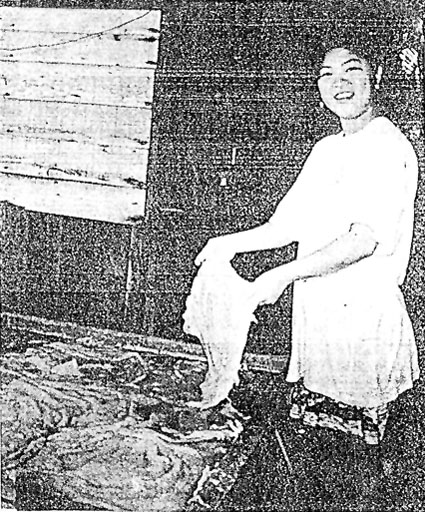
A fisherman's daughter at work in a jellyfish processing factory
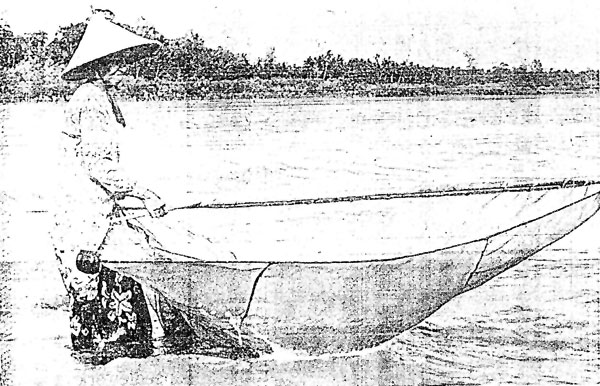
A fisherwoman at work with a large scoop-net
Unfortunately, this important role of women fish traders in small-scale fisheries is gradually being eroded with the introduction of more sophisticated fish distribution and marketing systems. Practising bulk buying and dealing directly with the fishermen, the growth of large wholesale trade even in small-scale fisheries has reduced the role of small fish traders to a considerable extent. Moreover, with the construction of modern landing and marketing complexes and the introduction of fish auctions in these complexes, it is envisaged that the hitherto important functions performed by small fish traders and dealers would gradually diminished if not completely wiped out. Should such displacement take place, it is not surprising if it is the women fish traders who would be displaced first.
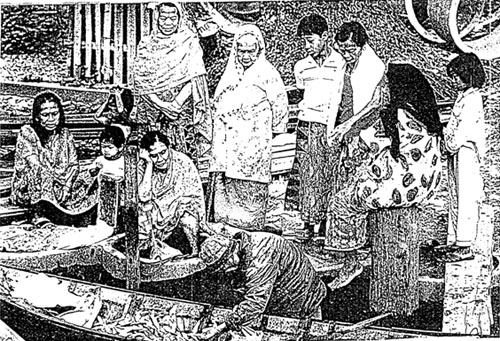
Women waiting to buy fish from a fisherman

Retailing of fish by women in the local market
Beside their involvement in fish trading and retailing, women in small-scale fishing communities on the East Coast are also engaged in other small retailing businesses. The women retailers characteristically operate in small huts outside their houses or in local markets in neighbouring villages and towns. Dry food provisions, household goods, fish and vegetables are some of the common items being sold by these women retailers. They usually carry out their retailing business with the help of children and adolescent family members.
Lately, women in small-scale fisheries are becoming increasingly involved in fish farming in consistent with the rapid development of aquaculture in the country. The participation of women in aquaculture extends to every aspect of fish farming like preparing fish feed, feeding the fish, cleaning of nets/cages and general maintenance and upkeep of the ponds or cages. It is recognized that fish farming is the most suitable option for the women to be involved since it does not require them to be away from their homes for long periods which might force them to neglect their household or domestic responsibilities. Furthermore, activities related to fish farming like preparing the fish feed, feeding the fish and minding the ponds/cages are often perceived as extensions of the women's household chores. In this way, the women are able to combine supplementary income-earning activities with household activities without having to neglect the latter. A study of the floating cage culture project4 in Sungai Merbok, Kedah, confirms that the women are extensively involved in activities related to fish rearing. The project was successful in drawing extensive involvement of women since it is based along the family unit concept whereby labour requirements are mainly supplied by family members.
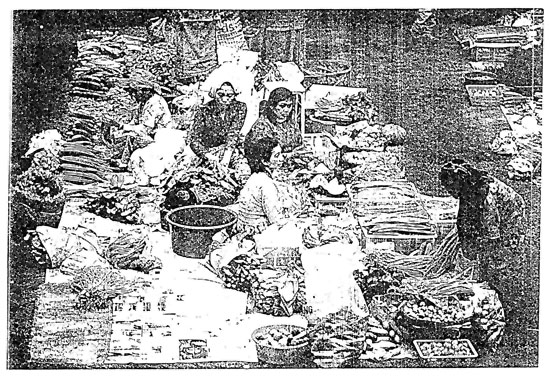
Women retailers in a local market, Kota Bahru, Kelantan
Another recent activity involving women's participation is in tourism-related activities. With the rapid growth in the tourism industry in the country and the availability of various incentives and supports extended by the government, it was reported that a few enterprising fishing families, especially on the east coast, have started operating holiday lodgings in the vicinity of their houses for foreign tourists. It is also reported that it is the women who actually undertake the daily management of the guest, houses, performing routined household activities like cooking, washing, cleaning, tidying and general housekeeping while their husbands are at sea fishing. As with fish farming/rearing, the women's involvement in running the guest houses or holiday lodging does not require them to be away from their houses and household responsibilities. Although only very few fishing households are currently taking up such tourism-related income-generating activities, the number would certainly increase in the future given appropriate incentives and supporting facilities. In this connection, agencies like TDC and KEJORA have initiated schemes specifically aimed at providing such business and employment opportunities in tourism-related industries to the fishing and other coastal communities. In view of this, therefore, tourism-related activities seem to be one of the most effective avenues for potential gainful employment of women in small-scale fisheries.
Besides their participation in relatively new fields like aquaculture and tourism, women in small-scale fishing communities for generations have been traditionally involved in the production of local handicrafts such as batik-making, songket weaving, brass and silver manufacturing and mat weaving. These cottage industries, which relied heavily on the conventional skills and craftmanships of the women, are usually operated in the premises of their homes, thus enabling them to combine household duties with income-generating activities to supplement the meagre household incomes. Farming is another significant supplementary income-earning activity undertaken by women in small-scale fishing communities, working either as seasonal farm workers or unpaid family labour in family-based agricultural production - planting, weeding and harvesting. The FAO study (1982) revealed that 27.5% of the total fishermen's wives with secondary employment were engaged in farming, especially in tobacco growing and padi planting. The study also showed that own businesses and retailing is another important supplementary income activity among the working women, providing employment to about 21.6% of the total. This is consistent with the general observation that the womenfolk on the East Coast of Peninsular Malaysia are more business-oriented than their counterparts on the West Coast, though this is more distinct in Kelantan than in the other states on the East Coast.
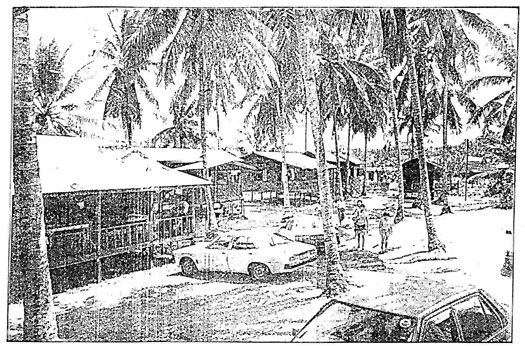
Holiday Lodgings for Tourists on the East Coast
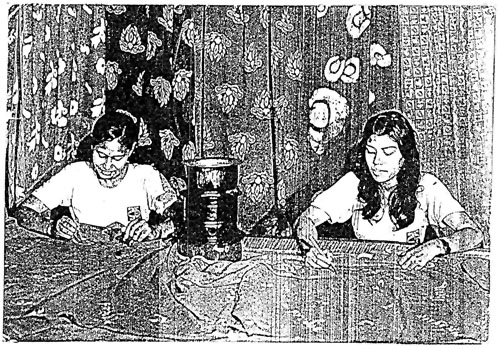
Batik-making by women
Several reasons can be advanced to account for the higher economic participation among women in the fishing communities on the East Coast compared to their counterparts on the West Coast. First, socio-economic circumstances of the East Coast fishing communities are such that the women are forced to seek additional incomes to supplement their meagre household incomes. Second, fishing activities on the East Coast are highly seasonal owing to the influence of the north-east monsoon. During the monsoon period, especially between November to January, rough seas and bad weather conditions prevented most fishermen on the East Coast from fishing, thereby compelling them and their household members to seek other alternative and/or supplementary income-earning activities. Finally, the traditional craftmanships inherited from their forefathers and the availability of local raw materials have enabled the East Coast women to pursue handicraft activities such as batik-making, mat and basket weaving and brass and silver making. It is noted that such natural skills and craftmanships are conspicously absent among the West Coast women.
From the above listing of economic activities undertaken by the women in small-scale fishing communities, it is apparent to us that their economic participation and contribution have been largely ignored and underestimated in the past. Granted that the economic roles played by the women are merely supportive and supplementary in nature, the fact remains that the women do contribute rather significantly to the household incomes and welfare. Unfortunately, as stated earlier, the full extent of women's economic participation in the small-scale fisheries sector has neither been emphirically researched nor adequately documented. In this connection, it is understood that a study on the involvement of women in the processing of fish and other marine products in Malaysia had been proposed at the BOBP meeting5 on Training of Women Extension Workers held in Madras, India in 1979. Unfortunately, such study has not materialized until now. This serious lack of research projects and studies on women in small-scale fisheries is as true today as it was a decade ago.